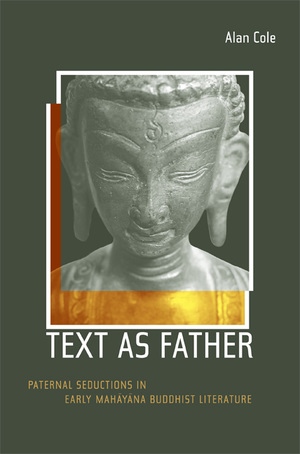Text as Father: Paternal Seductions in Early Mahayana Buddhist Literature
No edit summary |
No edit summary |
||
| (5 intermediate revisions by the same user not shown) | |||
| Line 7: | Line 7: | ||
|BookToc=** {{i|Acknowledgments|xi}} | |BookToc=** {{i|Acknowledgments|xi}} | ||
** {{i|Introduction|1}} | ** {{i|Introduction|1}} | ||
* {{i|1. Text as Father|25}} | * {{i|1. Text as Father|25}} | ||
* {{i|2. | * {{i|2. Who's Your Daddy Now? Reissued Paternity in the ''Lotus Sūtra''|48}} | ||
* {{i|3. The Domino Effect: Everyone and His Brother Convert to the ''Lotus Sūtra''|99}} | * {{i|3. The Domino Effect: Everyone and His Brother Convert to the ''Lotus Sūtra''|99}} | ||
* {{i|4. "Be All You Can’t Be" and Other Gainful Losses in the ''Diamond Sūtra''|160}} | * {{i|4. "Be All You Can’t Be" and Other Gainful Losses in the ''Diamond Sūtra''|160}} | ||
* {{i|5. Sameness with a Difference in the ''Tathāgatagarbha Sūtra''|197}} | * {{i|5. Sameness with a Difference in the ''Tathāgatagarbha Sūtra''|197}} | ||
* {{i|6. Vimalakīrti, or Why Bad Boys Finish First|236}} | * {{i|6. Vimalakīrti, or Why Bad Boys Finish First|236}} | ||
** | |||
** Conclusion: A Cavalier Attitude | |||
** {{i|Toward Truth-Fathers|327}} | ** {{i|Toward Truth-Fathers|327}} | ||
** {{i|Bibliography|347}} | ** {{i|Bibliography|347}} | ||
** {{i|Index|351}} | ** {{i|Index|351}} | ||
|AddRelatedTab=No | |AddRelatedTab=No | ||
|PublisherLogo=File:Univ. Califonia Press logo.png | |||
|PostStatus=Needs Copy Editing | |PostStatus=Needs Copy Editing | ||
|StopPersonRedirects=No | |||
|BookParentPage=Secondary Sources | |BookParentPage=Secondary Sources | ||
}} | }} | ||
Latest revision as of 13:53, 5 November 2020
This beautifully written work sheds new light on the origins and nature of Mahayana Buddhism with close readings of four well-known texts—the Lotus Sutra, Diamond Sutra, Tathagatagarbha Sutra, and Vimalakirtinirdesa. Treating these sutras as literary works rather than as straightforward philosophic or doctrinal treatises, Alan Cole argues that these writings were carefully sculpted to undermine traditional monastic Buddhism and to gain legitimacy and authority for Mahayana Buddhism as it was veering away from Buddhism’s older oral and institutional forms. His sophisticated and sustained analysis of the narrative structures and seductive literary strategies used in these sutras suggests that they were specifically written to encourage devotion to the written word instead of other forms of authority, be they human, institutional, or iconic. (Source: University of California Press)
| Citation | Cole, Alan. Text as Father: Paternal Seductions in Early Mahayana Buddhist Literature. Berkeley: University of California Press, 2005. |
|---|---|


